#they’re also doing body shape and character design things i’ve not seen anyone else attempt? Or at least not this well
Explore tagged Tumblr posts
Text
i finished Veilguard. It’s so fucking good, as a game, as an experience in having fun exploring a world, it’s visually and technically once of the best recent games I played, the world feels both big and not so sprawling that you get bored or bogged down running around. And as someone who adored the games for nearly a decade, it feels. So good. I’m so glad the team and devs got to create their vision. and even more so? I remember when both Harry and I got our first ever consoles, and got the games because so many of our friends said they loved it and thought someone who is into Tolkien might enjoy the fantasy aspects. That was 8 years ago, I hadn’t even gotten my undergrad degree! Now here we are, I love these silly little games so much, and Harry got to contribute to making aspects of the first ones we loved so much stand out even more!

These games mean so much to both of us, and it feels like yesterday we were just two silly nerds planning cosplays and writing fic together.
#This game is so good on a technical and emotional level#they’re also doing body shape and character design things i’ve not seen anyone else attempt? Or at least not this well#I feel like with most stuff that didn’t quite stick the landing you can tell they tried very hard
33 notes
·
View notes
Text
Why Hockey RPF?
Hey friends! This is a question I've been thinking about for a while, and I finally put together a list of my answers. Caveat that this is me attempting to analyze my own psychology and so may be very incomplete and/or wrong. :)
First, the general "why slash?" bits. These apply across fandoms (though I think some are extra strong in hockey, as I'll get to below).
One. Going against the script. I cannot stress enough how important this is to me in a romance. You know that thing where a man and a woman are in the same room together in a movie, so you know they're the love interests and they will kiss at the end? I hate that. It makes me feel like their love is probably fake. If they feel like they're supposed to be attracted to each other, and then they are attracted to each other, it probably isn't real attraction at all. Says my brain, anyway. If they feel like this person is not at all someone they could EVER be attracted to, and they're attracted anyway...it is instantly, like, fifty thousand times hotter to me. Works way better with gender for me than with other stuff that's traditionally been used in romance, like social class.
Two. Freedom from typical romantic gender roles. This has been said a lot, but: gender roles in romance SUCK. (They suck in most places. But romance really has a lot of them.) It's hard to grow up in a Western culture and not have an extremely conflicted relationship with them: you've been trained to find certain behaviors romantic, but you've also learned enough about feminism to question whether all of them are healthy or smart, and it's hard to write a satisfying romance when you're caught in the tangle of being drawn to the thing but also wondering if maybe you shouldn't be. It's so much easier for me to indulge my idtastic desires when I don't even have to think about whether I should be having the woman be the one taken care of, or if that makes her weak, so I should swap their roles, but then if she takes care of the guy does that mean she's doing all the work in the relationship and he's a giant man-baby...you see how that would bog you down. If both characters are men -- or women, or nonbinary -- it's easier to give them whatever roles I want without having to think about whether I'm furthering my own oppression.
Three. Getting to live in bodies that aren't our own. The previous point about gender roles can apply to femslash, too, and as a bi woman, I can get into that -- but sometimes it's better not to have to think about my own gender in the equation at all. There's so much crap associated with being a woman in our world, especially when it comes to sexuality. It can be liberating to write sex scenes when no bodies like mine are part of it even a little and you just don't have to negotiate the crap at all. This isn't an absolute for me -- I do write and enjoy femslash -- but I write way more slash than femslash, and I think this is part of it.
Four. Humanizing men. This is a big thing in a society (such as mine) where the best men are supposedly the ones who most embody a toxic masculinity where they don't experience normal human vulnerability or feelings. We're supposed to admire these men, and fall in love with them, and raise children with them (some of us), and it's so easy to resent and fear them instead. It is both satisfying and healing to portray men who are full of need and hurt and longing and love. Like, you know, humans are.
Five. Giving our desires power. In my culture, and in many others, men are the ones whose desires have power. A man wants a woman who doesn't want him back? He just needs to pursue her harder; she'll come around in the end, and if she doesn't, she's a heartless bitch. A woman wants a man who doesn't want her back? She's pathetic. Her desire makes her ridiculous. If you're a women who desires men, or who desires anyone at all, it's so humiliating to see your own desires minimalized and stripped of power like that. So if we want to write about our desires -- our desires for men, in particular -- it can be very satisfying to give those desires to another man. Those desires have POWER, then. They're legitimized. They have agency. We can revel in them without doubting our own right to have them.
So that's slash in general. Wow, there was a lot in there about cutting through the tangle of internalized patriarchy, wasn't there? Funny, that.
Hockey, though. Why hockey, amidst the many possible slash fandoms? Why did I start reading hockey RPF without ever having seen a game and fall for it so hard?
Six. The heteronormativity. And to take it a step further: the pressure in general to present yourself to the world as a certain type of person. I've written before about how a huge part of the appeal of the hockey world to me is the immense pressure it puts on its players -- which plays into the thing above about going against scripts, because the heteronormative script is extra in effect when it comes to professional sports, but it's not just that. These guys are under such a spotlight, and in exchange for their privilege and wealth they not only have to keep performing at an elite level that's hard to maintain, but they also have to force themselves into such a narrow, publicly acceptable mold. I'm not an athlete, so I can't relate to that specific set of pressures, but that makes them even more satisfying to write about. I can write about my feelings about the pressures that are on me -- the unwritten societal expectation to be important, successful, happy in easily recognized ways -- without having to think about those specific pressures, because I can substitute these ones instead.
Seven. Validation. I wrote above about giving our desires to men so that the desires have more power. In this case, it's giving the desires to successful, competent, famous people so that the desires have validity -- because the people who hold them have validity. Hockey players have the kind of prestigious, easily-recognized-at-cocktail-parties-and-high-school-reunions type of success that so many of us feel on one level or another than we should have, and they have it so unquestionably. When someone like that experiences a type of neediness I might feel -- the desperate longing for another person to notice them, the extreme obsession that comes with a crush, the miserable sureness that the person they want won't want them back -- that feeling is automatically valid, because THEY are valid. As someone who has felt a lot of longing in my life, I really enjoy exploring it in characters who have an automatic get-out-of-worthlessness free card.
So those are the navel-gazing ones, where hockey does the same kind of thing your average slash fandom does, but sometimes to a greater degree. Then there are the amazing storytelling benefits of the setting:
Eight. Team. Oh, team. Friends to lovers is my jam. I love writing characters who've spent so much time with someone, they don't even realize when their feelings for the other person cross the line from friendship to something else. This must be what friendship is, because it's what I feel for X person, who is my friend! And then the joy, of course, of having to see that person every day once you realize it isn't just friendship, and you're being tortured by knowing they'll never want you back (or so you think). Add in the thing where you and this person are fighting for something together every other day, where your successes bolster each other's, where your chemistry can mean the success of the team, and if you have a falling out (say, over someone's inappropriate crush) it could ruin your careers and the team's success...I mean, how do you resist a setup like that?
Nine. The flexibility of the setting. One of the wonderful things about hockey is that there's so much of it. If you want to set a story during a homestand, you can. If you want a road trip, you can find one. The season is seven months long, plus playoffs, and during those months you can set a story anytime and know that your characters will be seeing each other every day, creating lots of opportunities for interactions and relationship progress. And the hockey games themselves can feature -- but they don't have to. They can be just as important or unimportant as you need them to be for story purposes. Need your character to be down about something? Throw in a loss. Anxious about something? Mention a point drought. Sharing a happy moment with their person? Give them a win. If you're strictly following game schedules -- which I try to for the most part -- you might not be able to put those things exactly where you want them, but you can usually find a way to make your timeline match up with actual events. Unlike so many canons where there are specific, exciting adventures that have to be accounted for or worked around, hockey is years and years of fertile ground for whatever you want to put there.
(Corollary to the last one: this is a big part of why I find it so much easier and more fun to write fic than original fiction. When you write a novel, you usually need to create an actual plot, where external events impact each other and build to a conclusion. You can include a romance, but it has to be woven into these other events, and that gets complicated. Need a bonding moment? You'd better hope you designed your external plot to give them one. On the other hand, when you write fic, especially hockey fic, the hockey season can just march on merrily in the background, impacting your story only as much as you want it to, and you can pick and choose the parts of it that most strongly shape your romance. SO much easier to build and maintain a line of romantic tension that way.)
So those are my reasons. Put them all together, and they go a long way toward explaining why I write so much hockey -- and not just stories that borrow hockey players as characters, but stories set in the actual hockey world, with maybe an AU element, but hockey definitely present. There's just so much that the setting does for me and for my ability to write the stories that matter to me.
How about all of you?
70 notes
·
View notes
Text
bnha rewatch: episodes 10-13, part 1
In which I continue to explore villainy in the BNHA world by analyzing Tomura Shigaraki, his strengths, his weaknesses, his character connections (to All for One, All Might, Midoriya, and Bakugou), and his character design, particularly the significance of all those creepy hands. Prior rewatch analyses can be found by clicking the ‘bnha rewatch’ tag, or by clicking the link to my AO3 account at the top of my Tumblr if it’s easier to read them there.

“Encounter with the Unknown,” “Game Over,” “All Might,” and “In Each of Our Hearts”
Though Shigaraki debuted in the prior episode (“Yeah, Just Do Your Best, Iida!”), using the media as a cover to break into UA for information about All Might, these episodes are his true introduction. So let’s take a look at the character who may (or may not) become the Big Bad of the series.
The first thing that these episodes do is establish that Shigaraki is smart. He doesn’t act without information. The attack on the USJ only occurs after he breaks into UA and knows exactly where All Might is supposed to be (along with who else is supposed to be there with him). Additionally, the attack on All Might only occurs after Shigaraki learns that All Might’s strength is waning, when he can more likely be beaten in other words, and Shigaraki comes with a weapon designed specifically to counter All Might’s abilities (Nomu’s shock absorption to handle the damage dealt by All Might and regeneration to fix what can’t be prevented by the absorption). Furthermore, Shigaraki comes to the USJ with a strategy. He brings a villain who can block all signals coming into and out of the USJ, preventing anyone from calling for help, and he’s the one who told his lackeys not to underestimate the students simply because they are young. Their age does not matter. Their quirks do. Accordingly, Kurogiri separates the kids, sending them to all corners of the USJ, to groups of already gathered villains, to (in theory) make them easier to kill.
If we couldn’t already determine how smart this all is, three characters already associated with intelligence on the show- Midoriya, Momo, and Todoroki- all comment on the smartness of the plan in some way. As Todoroki says, the villains are “fools for trespassing here, but they thought this out, and they must have a concrete objective in mind.” Tsu aligns herself with this group by being the first to realize that the villains must have a way to kill All Might if that is what they came to do, an assertion quickly supported by Midoriya.
Of course, these displays of intelligence by Shigaraki could solely be attributed to All for One, especially since we learn at the end of “In Each of Our Hearts” that the information about All Might’s waning strength came from him. Similarly, All for One and his (as of now) unknown compatriot made the Nomu that Shigaraki uses. However, Shigaraki’s intelligence is on display during the attack as well. He is able to figure out the Aizawa’s quirk efficiency is deteriorating just by observing him, and this allows him to be the only villain (aside from Nomu, who is acting on Shigaraki’s orders) to get close to and hurt Aizawa. Furthermore, from the very first punch that Midoriya throws, Shigaraki is able to figure out that his power is similar to All Might’s and he can theorize about the personal connection between the two: “Are you one of All Might’s disciples?” This observation is not unique to Shigaraki. Tsu makes a similar one about Midoriya and All Might just in these episodes, and (of course) next season Todoroki will make his iconic observation of the obvious connection between the two (“Are you All Might’s secret love child o something?”). But these are characters who have proven their intelligence time and time again, so although the observation is not unique, the fact that Shigaraki can make it says something about his capability.
Shigaraki’s thoughtfulness is reinforced further with his critiques of the government, heroes, and violence. Shigaraki calls out Midoriya for attempting to kill him with his first punch, saying, “What kind of hero does something like that? You think you can get away with being as violent as you want if you say it’s for the sake of others? […] That pisses me off. Why do people get to decide that some violent acts are heroic and others are villainous? Casting judgment on as to what’s good and what’s evil.” He continues, saying to All Might, “You think you’re the symbol of peace? You’re just another government sponsored instrument of violence. And violence always breeds more violence.” All Might wholly dismisses what Shigaraki says, countering with the theory that Shigaraki’s doing this just because he likes it. But the show itself doesn’t support such a blanket dismissal. Society is messed up in BNHA, and it is messed up partly due to All Might. It’s not necessarily his violence that has bred more violence, but more (at least as of right now) his performative, solo heroism that has shaped society’s twisted notions about quirks and heroics. In part, Shigaraki has recognized this rot within society and the causal connection it has to All Might.
This isn’t to say that Shigaraki is wholly correct in his assertions either. He’s ready and willing to kill children after all when he breaks into the USJ. Granted, they’re super-powered heroes in training, but they’re still kids, as All Might points out. Yet Shigaraki is willing to kill them and kill them solely for the purpose of breaking All Might: “Let’s make this hurt.” So his judgment is not without serious flaws. However, he is not simply the crazy, violent hedonist All Might tries to characterize him as being.
It’s intriguing that this is the assertion All Might makes about Shigaraki’s villainy. He reduces the more complex motivation he states to something straightforward and simplistic, casting the former as nothing but a sham: “You’re nothing but a lunatic. Criminals like you- you always try to make your actions sound noble. But admit it. You’re only doing this because you like it.” To this, Shigaraki narrows his eyes and thinks, “He’s got me figured out.” Every time I watch this episode (“All Might”) I’ve found this moment intriguing. Has All Might truly figured Shigaraki out? Was Shigaraki’s philosophizing nothing but a vain attempt at justifying his awful actions? The fact that Shigaraki’s eyes narrow rather than widen makes me think he hasn’t been caught off guard by All Might’s surprisingly accurate assessment, but rather he’s been pissed off by All Might’s presumptuous dismissal. I read “He’s got me figured out” as angry and sarcastic rather than genuine. All Might thinks that Shigaraki is just your average, crazy, mindless villain, but he isn’t.
So why has All Might made such an assertion? Is this a sign of his flawed judgment, that he’s too old and doesn’t understand how villainy is done nowadays? Or was this a performative moment, designed to try to soothe the surrounding kids (Midoriya, Bakugou, Todoroki, and Kirishima)? I think a bit of both. A villain who isn’t just some mindless machine of violence (like the Nomu) would be a lot scarier, yet multiple comments have been made in the show (some by All Might himself) about how old he is. Shigaraki’s new approach to villainy is seen in the simple fact that he doesn’t come to the USJ alone. He comes as part of a team (the League of Villains), he comes ready and willing to work with them, and he laments when Aizawa prevents this from occurring: “[He’s] making it difficult for us to work together or rely on each other’s powers.” This places Shigaraki in a more direct parallel with the next gen heroes, who (aside from Todoroki and Ojiro) all fight in teams. It’s the adults (All Might, Aizawa, and Thirteen) who fight alone.
For all of Shigaraki’s relative positives (not acting rashly but according to an informed, logical plan), he’s still young and thus he’s still learning. He overestimates his position of strength in the attack, foolishly telling All Might what Nomu’s primary quirk is, which allows All Might to best him in the end. Additionally, he becomes EXTREMELY agitated at the first sign of his careful plan going awry and needs Kurogiri to calm him down. He nearly abandons the plan altogether when he learns that Iida escaped Kurogiri and that additional heroes are likely coming. Midoriya comments on this intent, saying how weird it is for Shigaraki to want to retreat at this point. Why put forth so much time and effort into concocting and executing a plan only to abandon it at the first sign of trouble?
You do this when it isn’t your plan.
I love Shigaraki’s design. All those hands. They of course emphasize his quirk, how devastating and deadly his hands can be. However, they also highlight his lack of independence. Shigaraki is not in control of himself. The hands are moving him around like a puppeteer does his puppets. All for One is moving him around like a puppeteer does a puppet. He directly tells Shigaraki at the end of “In Each of Our Hearts” that Shigaraki is his face to the world: “I must remain in the shadows. That is why you must be my face.” Shigaraki’s face is covered by the hand because it is not Shigaraki who is acting here. It’s All for One. Of course you’re going to lack conviction if what you’re doing hasn’t been decided by you.
Such control has devastating consequences on Shigaraki. He’s being held down and restrained by all the hands covering his body. He’s literally being suffocated by the hand on his face. It’s also blocking his ability to see. Sight is a common metaphor for knowledge and understanding in a story: the proverbial light bulb going off over someone’s head when they understand something. Shigaraki’s knowledge and understanding have likely been limited. The proof for this is in how shaken he is when circumstances deviate from the plan. A plan consists of pre-set actions based on already known conditions. Again, the knowledge of those conditions, as well as the actions to do in response to them, were likely given to Shigaraki by All for One. When the plan goes awry, when Shigaraki has to decide for himself what to do, he’s shaken, so he tries to abandon ship. I love the moment when All Might shows he’s not as weak as All for One said he would be. He literally knocks the hand off of Shigaraki’s face and forces him to see the truth.
All this is in contrast to Midoriya. I love the subtle and less subtle ways that the show connects Shigaraki to Midoriya. There is, of course, the bright red shoes, an immediate visual tie between the two. There are other moments, too. Both Shigaraki and Midoriya comment on how the big brawl between Aizawa and all the villain lackeys is not playing to Aizawa’s strengths. Thus they both possess comparable knowledge and intelligence. And then there’s the beautiful sequence when the show shifts from Midoriya’s eyes to All Might to Shigaraki’s eyes. Both Midoriya and Shigaraki have the same awe-struck expression on their face as they look at All Might, though for Midoriya his look is one of reverence while for Shigaraki his is one of hate. Finally, Midoriya and Shigaraki bear similar injuries at the end. Shigaraki has been shot in both arms and both legs. Midoriya has broken both of his legs and one of his arms/hands during the fight.
These connections help to highlight their contrasting trajectories at the end of the season. While Midoriya has had two trial by fire “victories” (first in his battle against Bakugou in “Deku vs. Kacchan” and then here at the USJ), Shigaraki loses. All for One tries to spin the loss as a chance to learn, and it can be. But it isn’t a confidence booster, not in the way that Shigaraki desperately needs. This parallels Bakugou, who has also lost to Midoriya and has had his confidence shaken. The connections between Shigaraki and Bakugou are more subtle at this point. If Midoriya and Shigaraki share red shoes, Bakugou and Shigaraki share red eyes. They both share a fondness for short pants and combative feelings towards Midoriya. And of course, All Might ties all three of them together, though in different ways (Midoriya → saving, Bakugou → winning, Shigaraki→ failing). These connections are why I’m still uncertain as to whether Shigaraki will be the Big Bad by the end. I find it just as likely that Midoriya and/or Bakugou will do as All Might failed to do and “save” Shigaraki as Shigaraki will destroy the hands holding him back and step into the spotlight as a fully independent villain. Recent events in the manga have only deepened my uncertainty regarding Shigaraki’s fate. Whatever the destination, the journey is sure to be an interesting ride.
Next time: while Shigaraki studied his butt off and failed the USJ test, the heroes (most of them) pass with flying colors. An analysis of the lessons they learn, with special emphasis on the four at the main fight: Midoriya, Bakugou, Todoroki, and Kirishima.
#bnha#my hero academia#boku no hero academia#shigaraki tomura#shimura tenko#bnha shigaraki#midoriya izuku#all might#toshinori yagi#all for one#katsuki bakugou#bnha meta#bnha analysis#bnha rewatch
17 notes
·
View notes
Text
Yugioh S3 Ep 18: Noah’s Dad Decides he Doesn’t Love His Son Anymore When Noah Gets Way Too Into Petz Hexing
I was hanging out with Bro and he made me look at a lot of bad Yugi wigs that were 600 dollars each, and because only like...4 good Yugi wigs exist in the world, I decided to help him get out that Yugi itch in a healthier way, by copy editing these posts and fixing the way I spell Gozaburo wrong about 400 more times before this arc ends.
So last we left off, Noah decided to reference that one part of the Bible he knows.
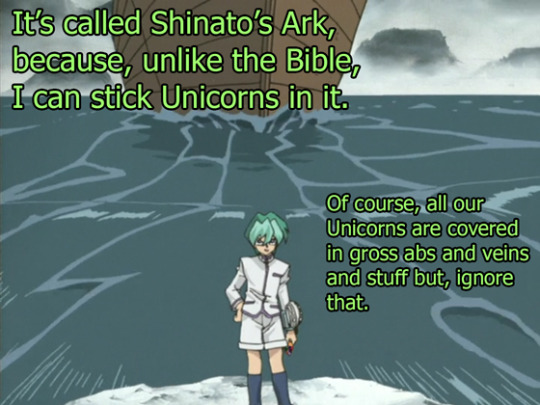
He’s gonna change the playing field to kind of run through the history of the Earth, showing us that in every period of history his outfit was never acceptable.
Also he got the history a...little bit wrong. You had to have people before Noah’s ark but...whatever. I took astrology, there’s a lot about planet formation we’re still kind of guessing on, so do whatever you feel like, Yugioh. It’s not like any kids watching this got real pissy about how Noah was totally botching the Archean period.
He also decides to dump on us how he got so smart. See, Kaiba got smart by studying a lot, surrounding himself with people way dumber than him, and then just bossing everyone around him until they agreed with him that he was very smart. In Noah’s case, it’s because he’s literally a computer.
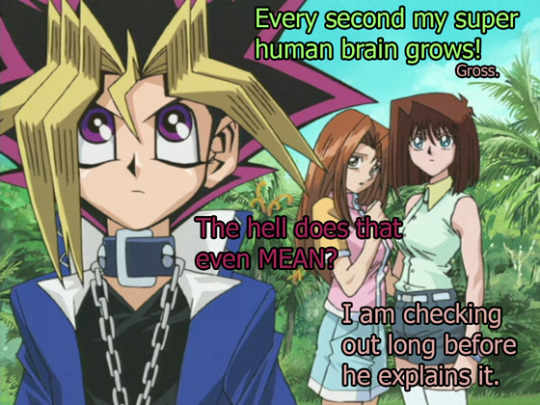
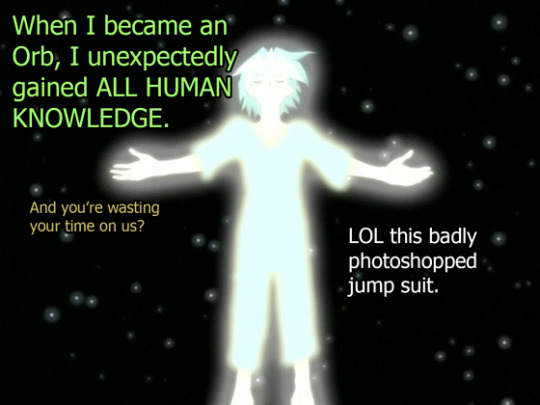

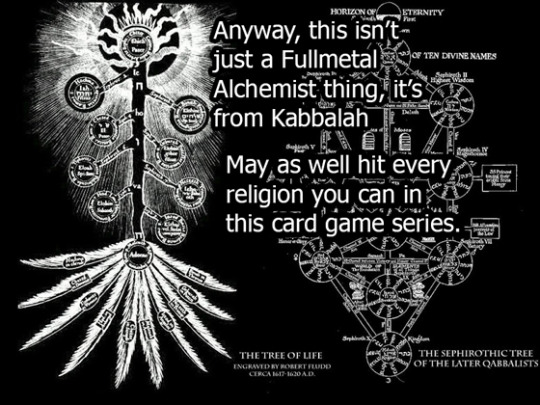
I’m really glad I get to find another anime that’s all ham about this tree. In this case just slapping it on there for a few seconds, long enough for me to say “WHAT THE HELL, KIDS SHOW?” before it vanishes again.
Good on you, Noah. You just...casually slipped that in there.

Ah, but unfortunately, the AI who is like...not even human and is *pretty sure* He’s Noah Kaiba is still kind of attached to his Dad. Maybe it was a part of his core code that he couldn’t reject his Father? I dunno, just seems weird that he achieved enlightenment and was like “So uh...I guess I’ll play cards and take over a mindless corporation. Good use of my time.”
(read more under the cut)
Kaiba’s reaction to hearing that his brother stores all of human knowledge was “well, it can’t possibly be that difficult. I’ve done way more than that. I have a homeschool degree and half a high school diploma so go to Hell, bro.”
Yo how many people would sit down, turn to their computer, and just start shouting at their core processor about how they’re waaaay smarter than it? Remember that during this entire conversation, Kaiba is shouting at a literal computer.

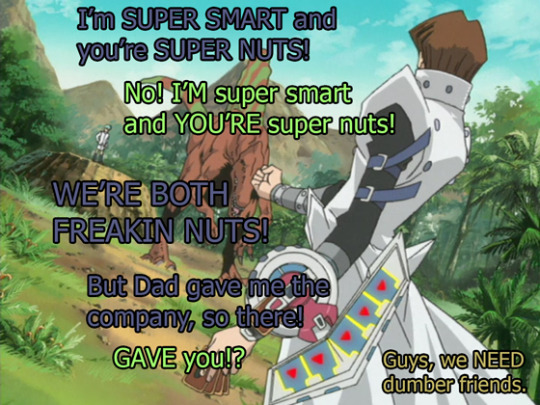
So anyway, we finally get to see why they bothered showing us spider room a few episodes back. Youknow, that room with the baby in it? Turns out...there was never a baby in this room, since Noah was a kid when he first woke up here.
Before it was covered in spiders, it was covered in blue and off white. This is a very boring Martha Stewart room in different shades of robin eggshell. You can tell this kid is a Kaiba because oh boy that is a...really boring 50 yo housewife look, ain’t it?
I’m sure it’s symbolic for the fact he is hella dead and innocent at this point but like...every time we see Kaiba interior design it’s just the last type of design you expect from this high octane family.
Anyway, Noah’s kind of surprised to be awake because, last he remembers, he was very much hit by a car.

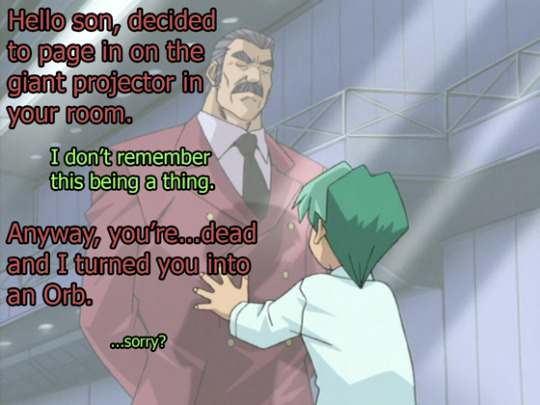
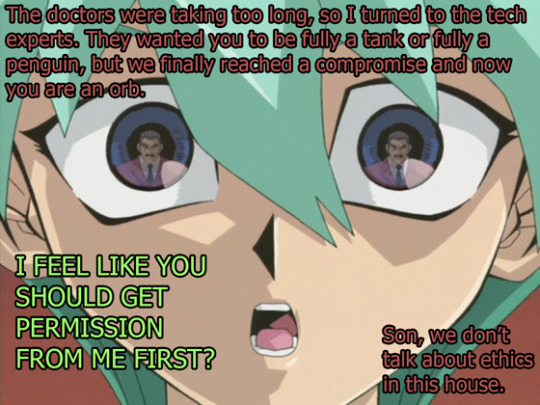
Ya, I mean, if you have to tell your son you Frankenstiened him into a horrible crime against humanity, might as well tell him as quickly and bluntly as possible, I guess.
Anyway, because Noah existing breaks the most basic moral human laws in every country on Earth, they kinda can’t let him go anywhere, which means that to prevent the loneliness, Kaiba gives him...a pet?
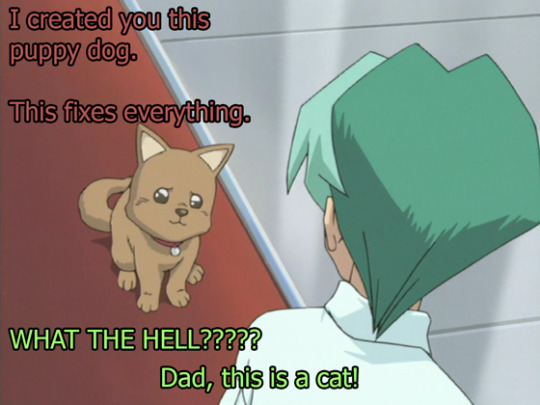
So Noah and the dogcat decide to travel through Domino and realized very quickly that there were only like...five NPC’s. There’s like an ice cream girl, and like a couple walking people, and that’s about it.

Noah’s words were something like “man this place is full of glitches!” because his dogcat wouldn’t stop barking and he threw a rock at it and it didn’t care. Glitches.
I guess it’s one way to look at it?
It feels like Noah got somewhat cursed like Pharaoh did, just a little bit. Like not completely it’s just that I can’t help but notice both are trapped in some sort of basic geometry shape--Pharaoh’s is a pyramid and Noah’s is an orb, and both have untold superpowers matched with some heavy depression that goes with having said superpowers. Not to mention, both have a host body all set up for possession, it’s just Kaiba is a little bit youknow...unwilling to participate. They’re very different obviously it’s just...way to trap your characters in shapes.
Anyway, last episode I felt like maybe Noah liked being an orb, this episode he’s made it a little more clear that it is kind of not great being an orb...but only because he can’t throw any rocks at dogs or have real conversations with anyone but his own Dad.
Anyway, Noah got a little bored. So his Dad sent him to virtual Mars.
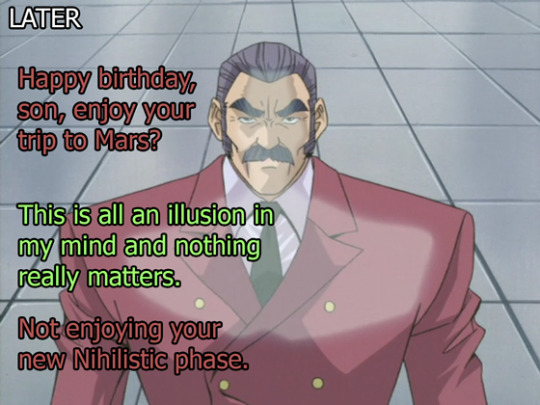
And now Noah only finds joy in hacking his digital pet. Relatable.
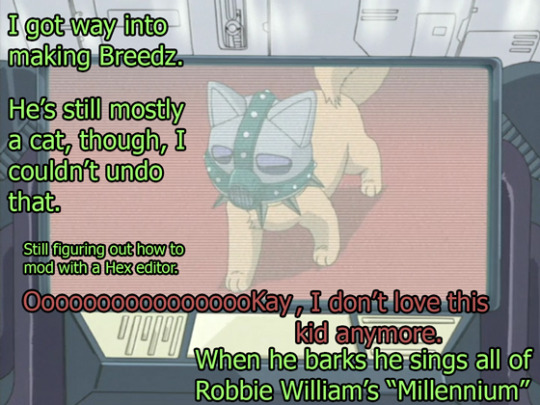
Now I know a good chunk of you are my age--that good Jenna Marbles age--and will know exactly what I am referring to, as for the rest of you, turning your digital pet into a hell creation was just a thing we all did in year 2000ish. All of us did this.
And I was like “I bet you, that someone out there has made a robot Hex, I guarantee” because I spent...I want to say 2 years of my life downloading modded breedz of Catz 4? I even tried to do it myself but I wasn’t any good at it because I was super young and bad at computers, I never actually got Robbie William’s Millennium as a Catz meow (though trust me, I did try. It was my life’s dream when I was small.)
But the closest I found to a Robot Petz was this?
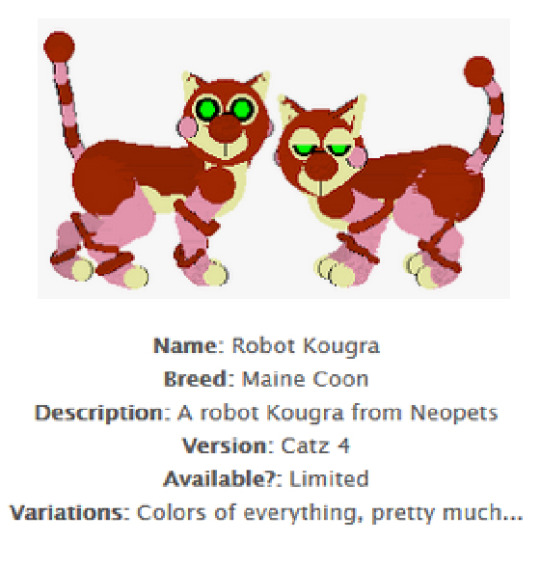
Dang. Look at that thing. This one is actually pretty good because it does resemble an animal. I admire it a lot. Trust me, I spent like days moving my bunniez feet around trying to make a dragon and just ended up downloading someone else's dragon.
And then, from the same page I saw this gem right above it.
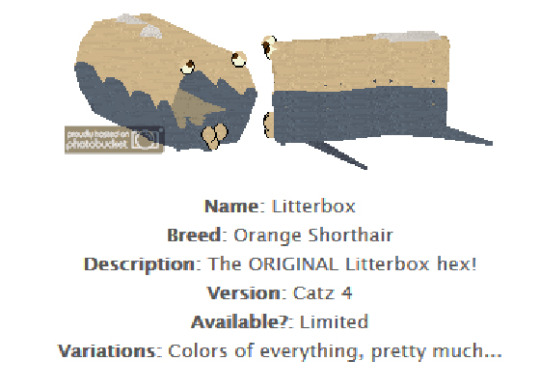
HELL YES........
....I freakin love this period of the internet so freakin much. I was only ever really a part of a couple of fandoms as a child and the Petz fandom will forever hold a little part of my heart. I mean, look at this. What’s not to love?
Like, Catz is probably number 3 on my list of best games ever made. Not so much because the game was any good, but because none of the files were protected in any way so even kids like me could hack in there and make the weirdest abominations and post them all to their Angelfire pages.
Well, other kids could, I was so baby that I was still using my Mom’s email address and did not know how to put a damn thing on my webpage. Which I did have. But it had like...only frames. It had like 3 words and just me splitting the page into 50 frames because I did not know what I was doing.
I apologize to all the kids in the room who have never seen a web page covered in ugly ass frames. You lucky bastards.
....but Petz...Noah was into PETZ. I can respect him for that.
I still think he’s a little creep-o, but knowing that he hacked his pet has given me a lot of appreciation for his work.
Anyway, it was after Noah changed the boring ass simpleton dog into a much better dog that Gozoboro decided “I have made a monster, I am abandoning my boy.” Which uh...this was the thing?
This?
I mean as far as body horror goes, Litterbox up there is way worse. As far as body horror goes, we also have, Jinzo over here, but the digital dog with a cute robot head was the thing that made Gozoboro say “What have I done!?” The dog is digital, it’s not even alive.
Especially since I feel like the follow up question Noah made was like way more frightening than the dog thing?


Kaiba glazes right over this entire conversation. Like full stop, he didn’t even seem to blink. No part of this story even slightly surprised him, although I will admit, at least Seto has decided that Noah...exists and might in fact be a robot his Father made once. This in itself is a big deal for Kaiba, who has a goldfish memory and denial wider than the sea he’s trapped under.


First of all, congrats to the storyboarder/animator for drawing a hand in that angle, mad respect.
Second of all, this is pretty close to the actual line from the show, Kaiba legit thinks that his Dad wanted Kaiba to be the president, after he knows full well that his Dad was like “Don’t Take Over My Company, You Little Twerp” and then like tried to even send Seto back to the orphanage whence he came. Kaiba’s pretty sure that his Dad wanted that whole thing to happen exactly the way it happened. No regrets. Just family being family.
And Moki’s still chilling on the Moki couch, just kinda taking this all in before he’s summoned unto the field like a playing card.
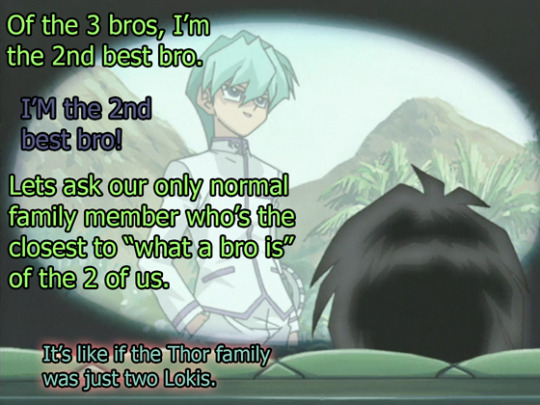

Ah, yet another person who is like “KILL MEEE” on this show. It’s been kind of a while. Like, who’s left that hasn’t stood in front of a loaded card-gun like this? Duke? Is Duke the only one who hasn’t sacrificed his body for the greater card-good at this point? Is this why Duke is our amoral Chaotic Neutral? Is this why Duke is still the only one who hasn’t died yet (and I’m crossing my fingers still that he’s gonna be our death 169, it can happen, I can believe)?



I feel like this is the season of weird hugs. Like everyone on this show that has hugged has gotten a little weird. The only not-weird hug was when Yugi attempted to hug Joey once and then Joey dodged the hug and wrestled him into an arm-distanced noogie instead--which is technically still not a hug, but the closest we’ve gotten to something a human would do. It is so lucky for our art team that all the huggers are supposed to be hella weird anyway.
Anyway, next episode we get to find out if Noah also had an AIM username or got really into Jelly pens. I can see him getting suuuper into Jelly pens, with hair like that.
Anyway, here’s a link to Season 1 Ep 1 to read in Chrono order, in case you just got here and you’re looking for that.
#yugioh#yu gi oh#episode recap#photo recap#S3 Ep18#catz 4#yo I'm so glad I got an excuse to talk about Petz with y'all#freakin petz#seto kaiba#noah kaiba#gozaburo kaiba#yugi muto#joey wheeler#duke devlin#tea gardner#serenity wheeler#for reals though I had 49 fake catz because the little assholes would not stop breeding#and as a child I was convinced they would all get jealous if I did not spend equal time with each#these catz were like an endless source of anxiety for me#I freaking loved them
32 notes
·
View notes
Photo
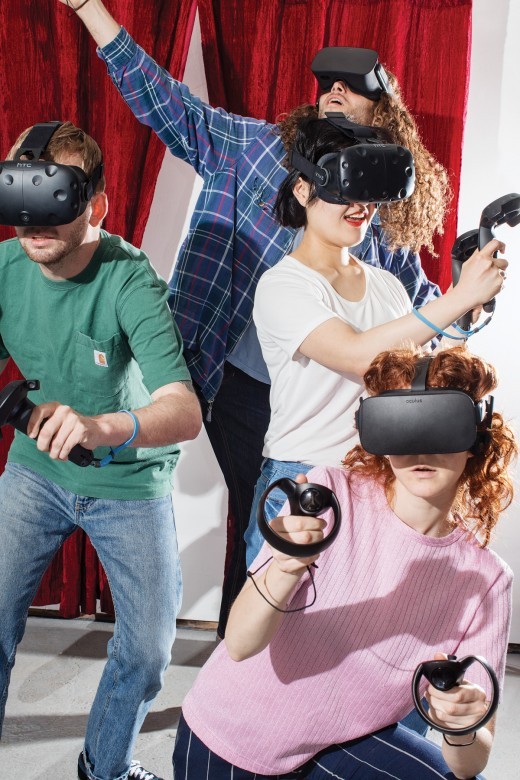
IN: 0366
Virtual Reality’s Missing Element: Other People
VR can be the basis of a new communications industry if the technology becomes less insular and isolating.
by Rachel Metz June 14, 2017
Unlike most people, I have a virtual-reality headset. I have exactly one friend who also has one. So most of the time I spend in VR, I’m all by myself. I can almost hear the digital tumbleweeds rolling by.
That’s a funny thing about this technology. Although it looks as if it must feel isolating to strap on a headset that shuts out the world around you, it could be great for socializing. When Facebook CEO Mark Zuckerberg spent $3 billion to buy the VR headset maker Oculus back in 2014, he pointed to the potential for social interactions as a key reason. And he’s right. Virtual reality can give you a sense of being with others that a FaceTime call on an iPhone will never match. Virtual reality could make it more emotionally fulfilling to connect with far-flung friends and family, or lend a feeling of physical presence to online classes that is impossible to attain otherwise.
But oddly enough, the social network hasn’t made social applications a focal point for the Oculus Rift headset, which launched in 2016. Primarily it’s still meant for playing games and watching short films. In April, Facebook released an app for Oculus Rift called Spaces to let you get together with your Facebook friends in VR. But it’s pretty humdrum. You can take a virtual selfie with your buddies, create a customized avatar based on your Facebook photos, and watch 360° videos or make 3-D doodles with a giant marker. You can interact only with the friends you already have on the social network, so unless your friends happen to have virtual-reality headsets too, you really can’t do much in Spaces but hang out all by yourself. And even if you do meet up with a friend in Spaces, it gets old quickly: you’re forced to stand around a virtual table the whole time. It seems that in order to avoid overwhelming early VR users, Facebook has gone too far in the direction of simplicity.
Recently I found a virtual social place that’s actually fun. It’s a free app for Rift and another high-end headset, HTC’s Vive, called Rec Room. Its virtual world is laid out like a cartoon version of a high school gym where you can play games like paintball and dodgeball, which you control with physical movements in real life. There’s also a big communal lobby called the locker room (for hanging out, not for changing in and out of virtual clothes—you can do that in a private Rec Room dorm room). In the locker room you can meet up with friends or strangers, shoot hoops, or play Ping-Pong.
Rec Room has plenty of flaws, but it nonetheless shows the power of today’s truly immersive virtual-reality technology to promote connections between people in ways that past attempts at virtual socializing—remember Second Life?—could never muster. The interactions with others are largely intuitive; to become friends with people in Rec Room, for instance, you shake their hands, which produces buzzing feedback in the handheld controller. I’ve had a blast spending time in Rec Room with my one other friend who uses VR, who in real life lives across the country. And it’s also the only virtual environment I’ve found that prompts you to connect with people you don’t know in ways that aren’t so awkward you want to rip off your headset.
“Even if you’re just … throwing darts into other people’s faces, you’ve kind of got a reason to be there.”
Although market researcher IDC believes 10 million virtual-reality headsets shipped last year, that number is tiny compared with, say, the smartphone market, where 1.5 billion handsets were shipped in 2016. And I think the technology will struggle to snag more users—and thus to come down in price from at least $800 for a headset and VR-ready PC—unless it becomes more social. It’s not that virtual reality isn’t fun on your own. It’s delightful to get transported somewhere by pulling a headset over your eyes and headphones over your ears. But no matter how entrancing virtual reality is, it’s ultimately a lonely escape if nobody else is around to enjoy it with. If experiences like Rec Room catch on, VR may become the first true post-smartphone social platform.
STRUCTURED SOCIAL
Rec Room, made by a company called Against Gravity, is not very advanced visually. When I pop in to the app, I embody what I think of as Geometric Rachel: an ovoid head, rectangular torso, and mitten-like hands, with glasses and a hairdo that looks like a bob-shaped helmet. But even within the confines of this simple avatar, I have a surprising amount of fun hiding in shipping containers and shooting at opponents (including my VR buddy) in a giant game of capture the flag.
Things reviewed
Rec Room Altspace VR High Fidelity Facebook Spaces
One day I connected with Against Gravity cofounder and chief creative officer Cameron Brown for an interview in the app’s locker room. His avatar was decked out in square purple glasses, a black baseball cap, and a white tank top with an orange Rec Room logo—a simple happy face—on the front. His hand suddenly fell to the ground; the app was having network issues, he said. He whisked me away from the clamor of the locker room to a big, empty lounge with a wood floor, a Ping-Pong table, and couches that our legless bodies couldn’t actually sit on. It’s the rare private space in Rec Room, which anyone can use and invite others into. He said some people have taken to using the space for meetings, and there are a conference table and whiteboards in one corner just for that.
Since VR technology is still so new that most of us don’t have lots of friends using it, and interacting with strangers in virtual reality is about as awkward as doing so in real life, Rec Room is using slightly unconventional methods to get you to socialize. It literally forces you into games. Brown calls it “structured social.” If you and a few others enter the gym around the same time to play dodgeball, for instance, Rec Room’s software will automatically sort everyone into teams and an overly chipper, British-accented woman’s voice will suddenly start counting down the seconds until the match begins. Before you can think about it, you’re thrust into a game. “Who enjoys going to a party where you don’t know anybody, and just walking into a room and going, ��Hi’?” he said.
What do you want to use virtual reality for? Tell us what you think.
True enough. Still, Rec Room’s ice-breaking methods can be jarring at first, like the time I suddenly found myself wielding a giant pen in a game of 3-D charades. Like most people, I do prefer to socialize with those whose interests I share, rather than complete strangers, and that’s not necessarily Rec Room’s aim (although you can set up private games with just your friends). Eventually, though, this sink-or-socialize tactic got me to loosen up and enjoy myself rather than stand around trying to work up the nerve to talk to others. “Even if you’re just mucking around in the locker room throwing darts into other people’s faces, you’ve kind of got a reason to be there, and before you know it, half an hour’s gone by,” Brown said.
Mindless fun or not, Rec Room was remarkable for how it gave me a sense of being in a space with other people, especially my friend who is thousands of miles away. We were giddy at being able to communicate and be together in a new way. It was much more enjoyable than Facebook Spaces, where there’s not enough to do, and another social app, AltspaceVR, where there are too many options for socializing, none very entertaining.
AVATAR ISSUES
If you’re hanging out in virtual reality, you’re going to need a body, and what this body must look like, or whether it even has to be human, depends on the context. Often, it seems cartoonish human figures are best for staying clear of the uncanny valley, since it’s still difficult to make avatars look just like us. (Probably the most realistic-looking avatar I’ve yet seen belongs to Second Life creator Philip Rosedale in his new social VR app, High Fidelity, and even that one doesn’t look quite like him.)
Regardless of how well designed your avatar is in VR, one way these worlds resemble real life is that your perceived gender shapes the interactions you have. In Rec Room and other socially geared apps, like AltspaceVR and Facebook Spaces, I prefer to make my avatar female—and preferably similar in appearance to me, with brown hair and, when it’s an option, glasses. Being true to your actual identity can make you feel that your virtual self is authentic, but as a female character you’re likely to face behavior that is obnoxious or worse.
I haven’t experienced anything that bad. The worst was when some whiny, mouth-breathing adolescent boy complained that I sucked at a game: admittedly, it pissed me off and hurt my feelings a bit. (To be fair, I was terrible at several of the games.) But Brown acknowledges that harassment can be an issue. He told me of an incident in which the fiancée of a regular Rec Room user tried out the app and found a bunch of other players instantly in her face when she entered the locker room.
Simple tools to counter these behaviors are critical, but like VR itself, they’re still very much in the experimental stage. Rec Room and AltspaceVR let you mute offensive users or build an invisible cushion around your avatar to make bullies disappear if they get too close. Rec Room also lets players vote on whether someone should be kicked out of a game. These tools will have to get more advanced and intuitive.
It could take several years for headset prices to drop and for a range of apps to figure out the interactions we want to have with each other in virtual spaces, making VR so compelling that, like the TV, PC, and smartphone, it becomes something the average person wants to use. Rec Room is not going to be that killer app for many people. But because it’s focused on certain activities and thoughtful about how to promote social interactions, it’s a good model for what’s possible. I hope it can stick around until there are many more people to play with.
0 notes